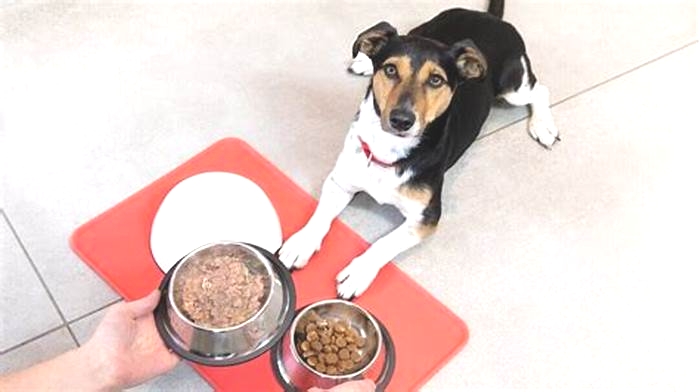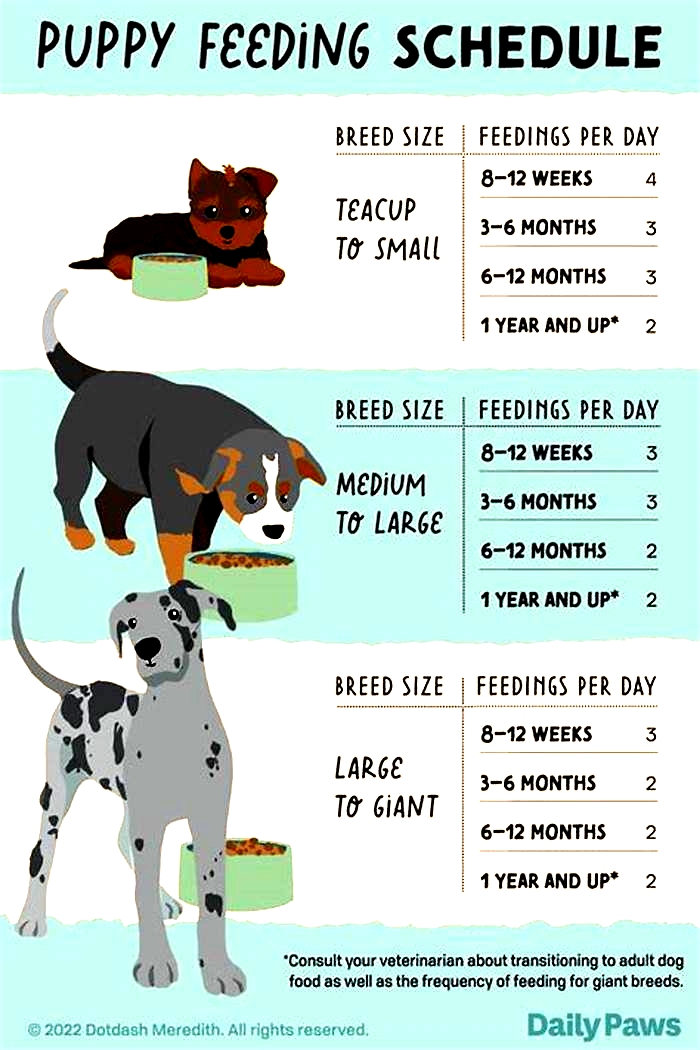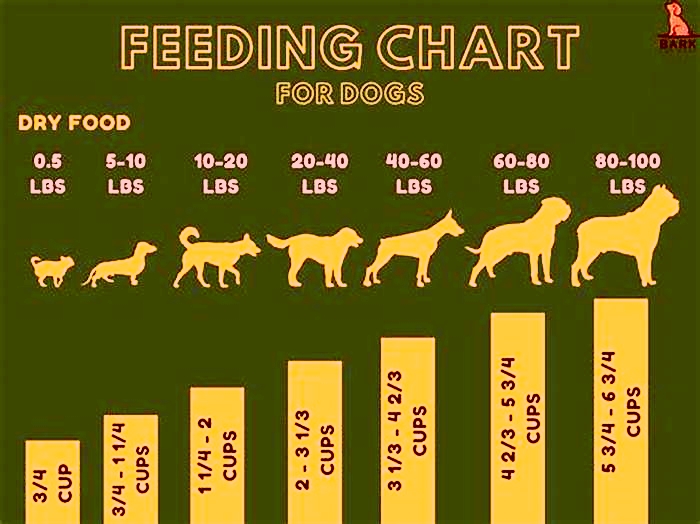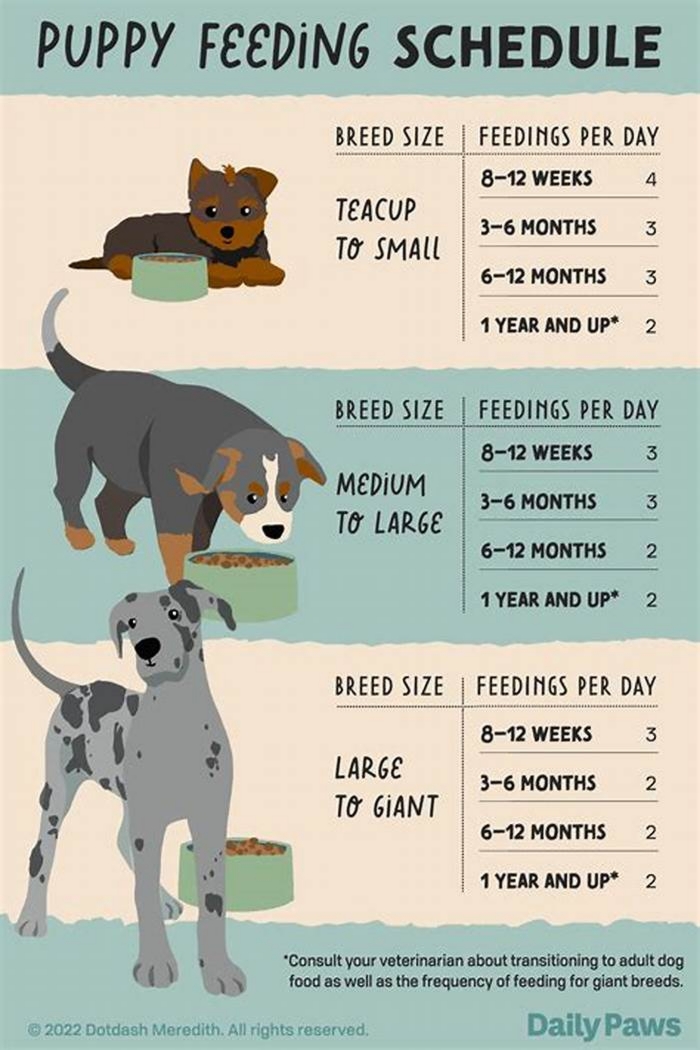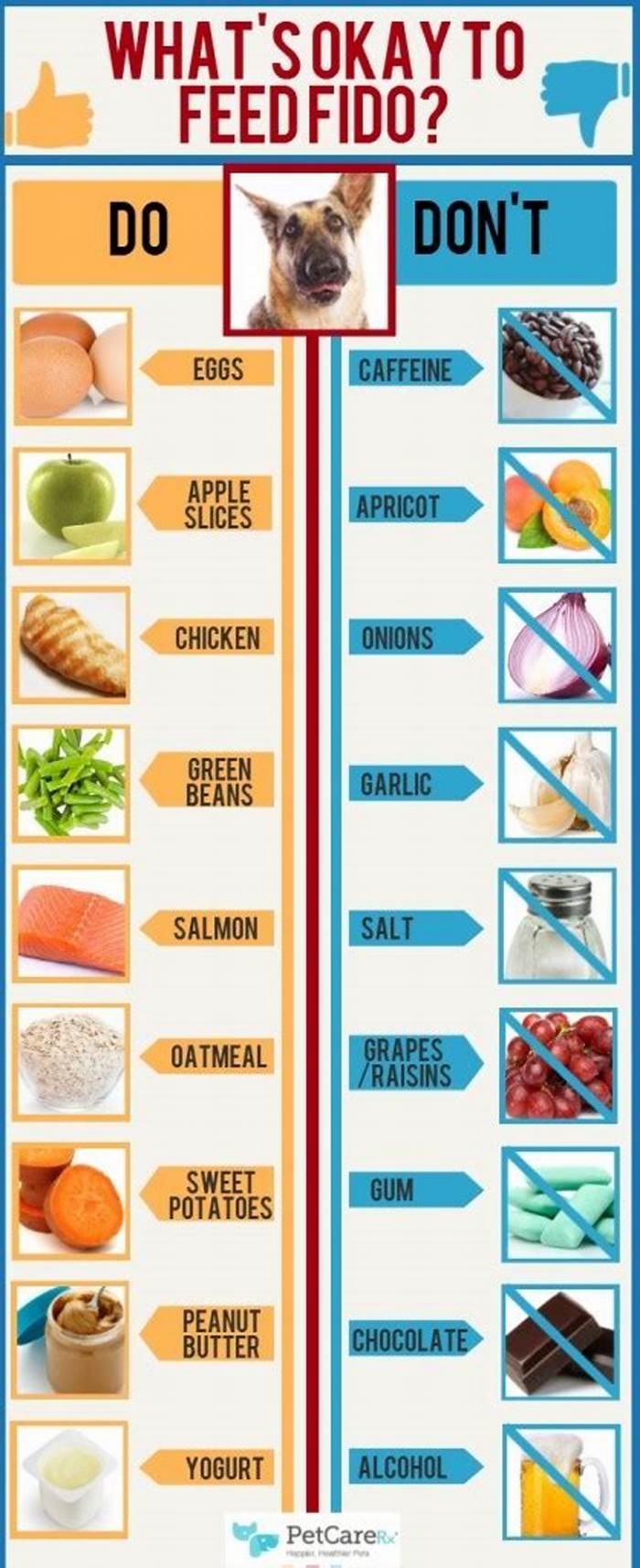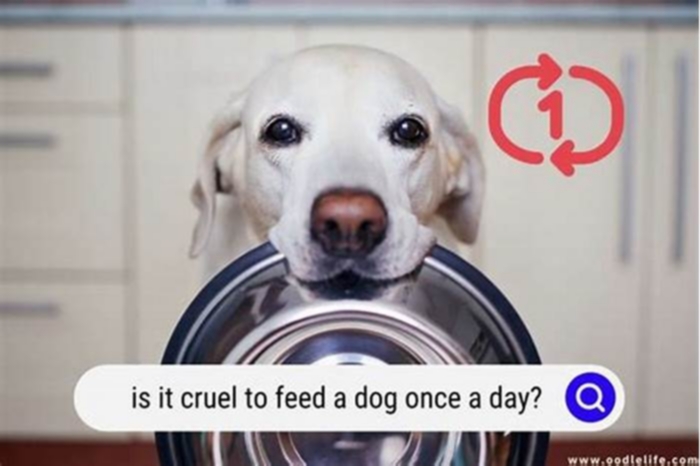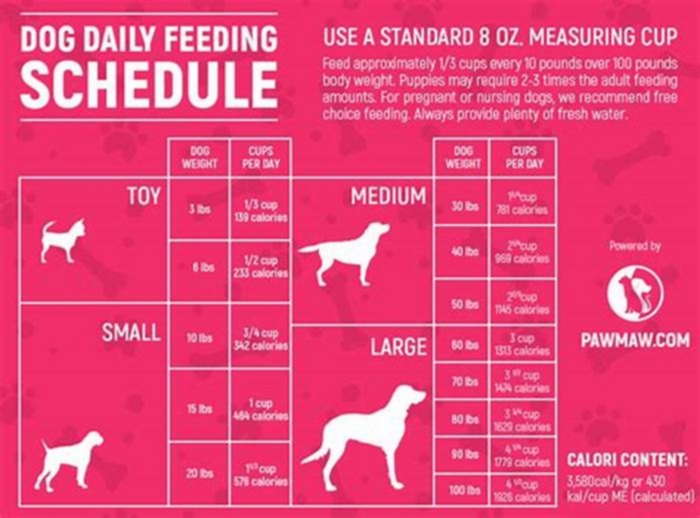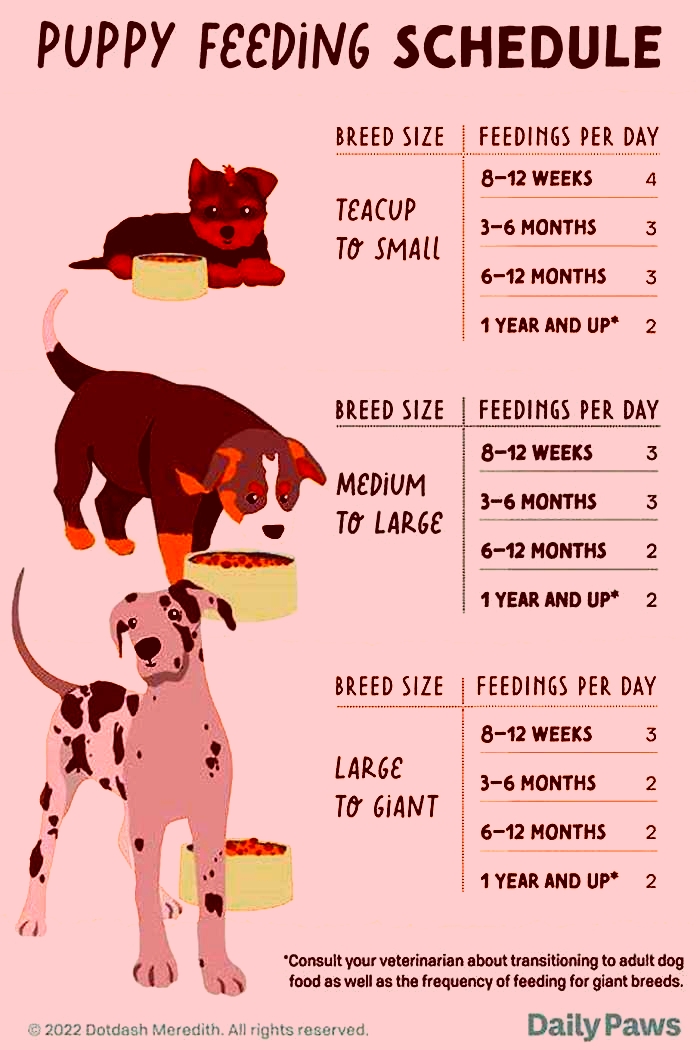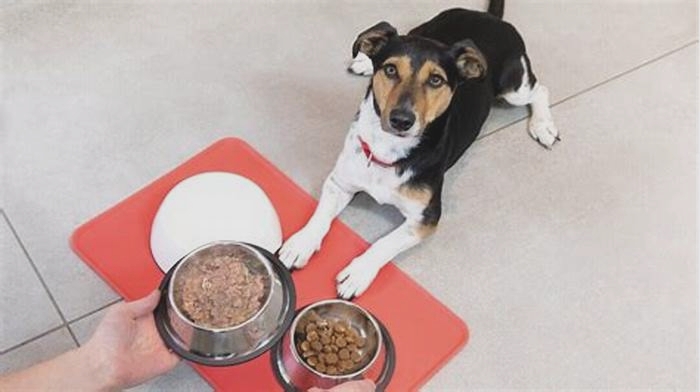When to feed a dog twice a day
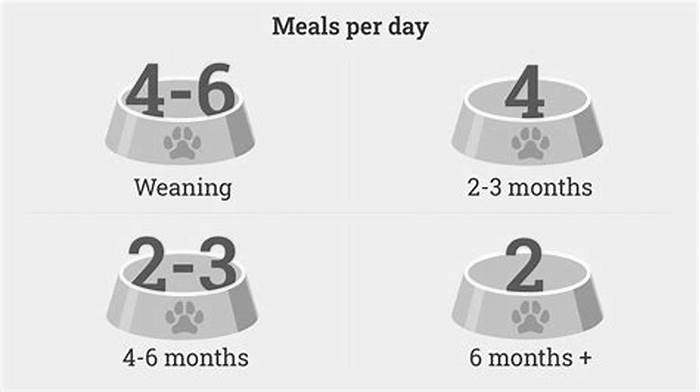
The Pros And Cons Of Feeding Your Dog Once A Day
The most common feeding schedule for adult dogs is one or two meals daily. I recommend that most people feed their dogs twice a day. But feeding your dog once a day can work well in some circumstances.
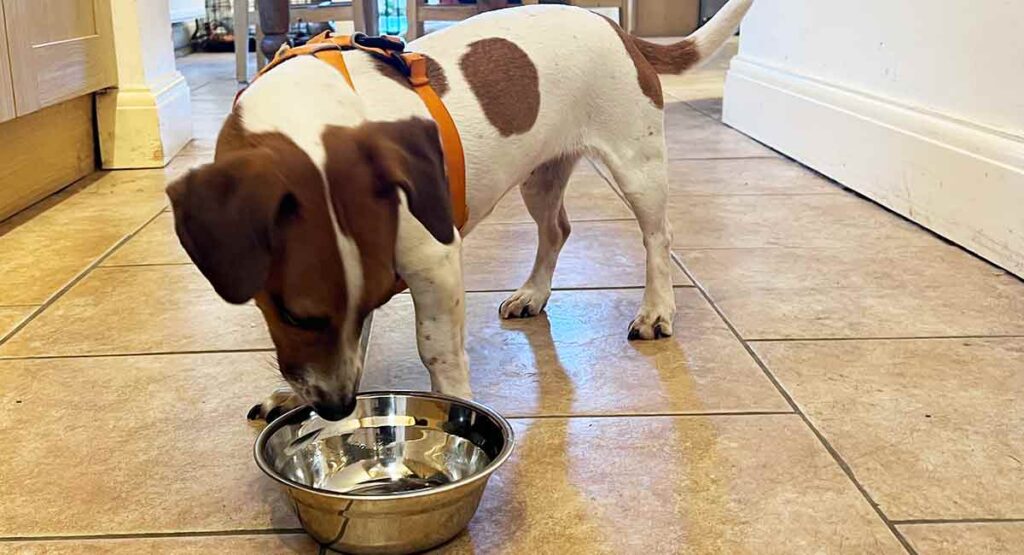
The best feeding schedule for your individual dog will depend partly on the type of food you give them. And my advice is based on my own forty years experience of feeding both kibble and raw, to dozens of different dogs.You can check out what I feed my own dogs each day in this article
Considerations
Is it cruel to feed a dog once a day?
The short answer is no. Traditionally almost all adult dogs were fed once a day. This was the norm when I was a kid. The rationale behind this schedule is that dogs are carnivores, and it is natural for them to eat a large amount of food in one go, and then fast for many hours, before eating again.
In those days most dogs were fed on a mixture of canned (wet) dog food, and dog biscuits together with scraps leftover from human meals.
However, most modern dogs are fed on kibble. And with dry food, feeding once a day has some disadvantages. Lets dig into those, and help you decide how often to feed your dog.
Natural feeding patterns
Its true that your dog is genetically almost identical to the wolves from which they descend. Wild wolves or other dog species hunting in groups may bring down a large prey animal, and feast on it. Then not eat for a day or two.
Its also true that dogs have been catching much smaller prey and scavenging from humans for thousands of years, and have adapted well to eating smaller and more frequent meals.
Pros and cons large vs smaller meals
Feeding once a day is convenient. And with a raw diet, it can be safe and satisfactory for most medium to large dogs
The natural diet of a dog, raw meaty bones, organs, eggs, and even invertebrates such as worms and beetles, are all processed very quickly by a dogs digestive system. Its designed perfectly for the job. And because there are no fillers or carbs in this food, it isnt very bulky. Everything is digested with little waste.
With kibble, feeding once a day only, can be problematic for some dogs. Its all to do with the portion size. And of course once daily meals are twice as big as twice daily meals.
Big dogs
It can be risky to feed a large or deep chested dog their whole days ration of kibble in one hit. Thats because these types of dog are more prone to suffering from bloat.
When we feed our dogs on kibble, we are asking the dogs digestion to take on a task that it isnt quite designed for. Along with the protein, fat and minerals that your dog needs, are a lot of bulky fillers.
While the food looks and feels light and compact when you pour it into the bowl, at that point it is completely dehydrated. It starts to swell up inside your dog as soon as they start to drink.
Its worth thinking about what happens to the bowl of kibble your dog just ate, when they head over to their water dish. Try dropping a few pieces into a glass of water to see how much they expand!
Your dog needs that water so dont ration it. But be aware that they can end up with a lot of heavy food sitting in their stomach, and this may increase their risk of suffering from bloat.
Little dogs
Small dogs often need a minimum of two meals per day, in order to feel well. My own Jack Russell terrier will often vomit if she misses her breakfast, and this is quite common in little dogs.
Some small dogs also find it hard to consume enough in one sitting to keep their weight up. So feeding twice a day may be necessary for many dogs weighing much less than around 20lbs.
This rule applies with both raw food and kibble.
Puppies
All puppies need feeding more frequently than adult dogs.
Most kibble fed puppies need at least four meals a day until they are three months old, then three meals a day until six months.
Some raw fed puppies can drop a portion a bit sooner.
Food should be fun
Aside from the health and safety issues around eating kibble, food is a source of great pleasure in our lives, and dogs feel the same way. They enjoy their meals. And look forward to the next one.
Most dogs eat kibble quite fast. Its unusual for a dog to take more than five minutes over their meal. And twenty four hours is a long time for a kibble fed dog to go between meals, especially when the last meal was over so quickly!
Raw meaty bones take a lot of time to consume, and can keep a dog occupied happily for half an hour or more. But even so I think there is a lot of pleasure to be gained if this experience happens twice in each day rather than once.
Which is best? One meal or two?
Your adult dog will most likely thrive whether you divide their daily ration into one meal or two. However, if your dog is large or deep chested, and fed on kibble, I recommend you feed twice daily, dividing that ration into a morning and evening feed.
Obviously, twice daily meals doesnt mean twice the quantity. You feed the same daily ration but divide it into smaller portions
I do think it means twice the fun though!
And while once daily feeding is suitable for all but the smallest raw fed dogs, I feed all my dogs raw, and, twice daily
Let me know what you decide to do!
Im always interested to hear from readers about how they feed their dogs, so do drop a comment in the box below!
Get Pippa's free dog training tips delivered to your inbox
What is the Best Time of Day to Feed your Dog? (According To The Experts)
Article Last Updated April, 2024
Key Takeaways
- Regular meal times are crucial for your dogs digestion, energy, and overall well-being.
- Free feeding can lead to overeating and weight gain; regular meals help maintain a healthy weight.
- Proper feeding goes beyond nutrition; its a vital part of caring for your dogs overall well-being.
Hello, dog lovers! As dog parents, we always aim to keep our four-legged mates happy, healthy, and well-fed. But what time should your dog eat?
Feeding is more than just putting kibble in a bowl. Its about understanding their nutritional needs, age, health, and lifestyle.
Why does this matter? Feeding your dog at the right time impacts its health and behaviour.
Regular feeding can maintain a healthy weight, support digestion, and promote better behaviour.
In this article, we delve into canine nutrition, guided by experts, to uncover optimal feeding times. Well explore the best times, the pros and cons of feeding once or twice a day, and puppy feeding requirements and provide a sample feeding schedule.
So, grab a cuppa, get comfy, and lets journey into canine nutrition. Its time to optimise feeding time for your dog.
The Best Time to Feed Your Dog
While theres no one-size-fits-all answer to the best time to feed your dog, most experts agree on a few general GUIDELINES.
Typically, most adult dogs should be fed twice daily, with meals ideally spaced 10-12 hours apart to support their digestion and keep ENERGY LEVELS consistent. This could mean serving their morning meal early, around 7 am, and dinner early in the evening, at approximately 6 pm.
However, remember that every dog is unique, and their feeding times might vary based on age, health, and lifestyle. Ensuring your dog has a consistent feeding schedule is more IMPORTANT than the specified time meals are given.
Tailoring the feeding schedule to your dogs specific needs will help them stay happy and HEALTHY. Always remember consistency is key when it comes to meal times.
Feeding Your Dog Once a Day
Adopting a once-a-day feeding schedule for your dog can be a PRACTICAL solution for some. The convenience it offers can fit seamlessly into a hectic routine.
Moreover, some argue that a single daily meal aligns more naturally with a dogs instinctive feeding habits in the wild, where they would feast when food is available.
However, its key to note that this approach isnt ideal for all dogs, especially smaller breeds. Smaller dogs have faster metabolisms and, therefore, may require more FREQUENT MEALS to sustain their energy levels throughout the day.
On the other hand, larger dogs often have slower metabolic rates and might be content with one WELL-BALANCED meal a day [1].
Pro Tip: If you feed your dog once a day, its best to give them their meal in the morning as it provides fuel for the whole day and prevents overeating at night.
Feeding Your Dog Twice a Day
Many vets recommend feeding an adult dog twice a day, as this routine can offer several BENEFITS to your pets health and well-being.
A twice-daily feeding schedule helps maintain STABLE BLOOD SUGAR levels and provides a steady energy supply, keeping your dog active and content throughout the day.
This practice is backed by research. A study by The National Institute of Health showed that dogs fed once a day were more likely to GAIN WEIGHT. In contrast, those fed twice daily had stable body weights throughout the research period and lower calorie consumption overall [2].
Twice-daily feeding can help reduce bad behaviour due to boredom and hunger and prevent them from binging on food when given the opportunity.
How Often Should You Feed A Puppy
Feeding your puppy properly is key to their GROWTH and development.
Up until 8 weeks, puppies should primarily feed on their mothers milk. Its important not to adopt a puppy before this age, as premature weaning can lead to behavioural problems later in life.
From 6-8 weeks, puppies can start having SMALL PORTIONS of dry food four times a day alongside their mothers milk. As they grow, their diet needs to change too.
By the time theyre 2-3 months old, puppies should be weaned off their mothers milk and be on 3-4 solid meals a day.
The exact number of servings of dog food will depend on the BREED of the dog, with smaller breeds often requiring different feeding schedules than larger ones.
As your pup matures and becomes accustomed to solid foods, you can adjust its feeding schedule.
At 3-6 months, you can reduce the number of feeds to three times daily.
By the time theyre 6 12 months old, this can be gradually REDUCED to two meals a day.
Choosing the right food for your puppy is crucial to this process. For detailed information on the best foods to support your puppys growth, be sure to check out our article on the best puppy food.
Pro Tip: Remember, not all breeds are classed as adult dogs at the same rate. So, its essential to tailor the feeding schedule to the specific needs of your breed.
How Often Should You Feed Senior Dogs
Feeding our senior dogs is a bit like fine-tuning a beloved instrument. As our furry friends age, their activity levels decrease, and their metabolism slows down, affecting their dietary needs.
Many vets suggest sticking to a twice-a-day feeding routine for our golden oldies. Smaller, more FREQUENT MEALS can be easier on their tummies and help keep their blood sugar levels steady.
But, just as each wrinkle tells its own tale, each senior dog has UNIQUE health considerations.
Keep a watchful eye on your dogs weight and overall condition as they age because our senior companions might be more susceptible to weight changes.
Pro Tip: Ensure your senior dog eats in a calming environment to reduce stress and encourage them to finish their meal.
What Is Free Feeding?
Free feeding, you ask? Its a bit like a buffet for dogs, where their food is available all day to nibble at their leisure.
Sounds pretty convenient, doesnt it?
Especially for those of us with erratic schedules, this feeding method seems like a TIME-SAVER.
However, before you start filling up that food dish to the brim, lets delve a little deeper.
Free feeding, while appearing convenient, can often lead to OVEREATING and weight gain in many dogs.
A study published in the Journal of Veterinary Internal Medicine found a link between free feeding and obesity in dogs, mainly because its challenging to monitor their calorie intake [3].
Each dog is a unique character with individual nutritional needs. Free feeding doesnt consider these, and it can be especially risky for dogs prone to weight issues or those with specific dietary needs.
A Dogs Feeding Schedule
Ever noticed how our four-legged friends seem to have a sixth sense about when dinners on its way?
Thats because dogs thrive on routines, including a regular feeding schedule.
This routine not only satisfies their tummies but also brings a sense of predictability and SECURITY to their day.
This can be particularly beneficial for rescue dogs, who may have experienced inconsistent care in the past.
A sample feeding routine could look something like this: breakfast served at 7 am, perhaps a small midday snack or treat for training, and then dinner at 6 pm. But remember, this isnt one-size-fits-all.
| Time | Activity |
|---|---|
| 7:00 am | Breakfast |
| 12:00 pm | Midday snack or treat for training |
| 6:00 pm | Dinner |
As I have said before Our dogs are as individual as we are, so a chihuahuas feeding schedule might DIFFER from a labradors.
Sticking to a meal schedule helps to maintain REGULAR bathroom habits (trust us, youll appreciate this one!), supports healthy digestion, and can even alleviate anxiety by providing structure to your dogs day.
So, as we navigate the world of doggy dining, lets remember the importance of a CONSISTANT feeding schedule.
Its more than just filling their bowl; its about providing our dogs with a routine that helps them feel secure and loved.
After all, they do say that the way to a dogs heart is through its stomach!
Conclusion
And there we have it, folks! The ins and outs of when to feed our precious pups. Whether theyre sprightly puppies, energetic adults, or golden oldies, its clear that a regular and well-considered feeding schedule plays a pivotal role in their health and happiness.
From early morning breakfasts to evening dinners, the timing, frequency, and consistency of meals all contribute to our dogs well-being.
But remember, just as no two dogs are the same, their feeding schedules will differ, too. Always consult with your vet to tailor the feeding schedule to your dogs unique needs.
So, as we embark on this feeding journey, lets remember that were doing more than just filling their bowls. Were providing love, care, and nourishment, one meal at a time.
Sources
- Middleton RP, Lacroix S, Marie-Pier Scott-Boyer, et al. Metabolic Differences between Dogs of Different Body Sizes. 2017;2017:1-11. doi:https://doi.org/10.1155/2017/4535710
- Bray EE, Zheng Z, M Katherine Tolbert, McCoy B, Kaeberlein M, Kerr KF. Once-daily feeding is associated with better health in companion dogs: results from the Dog Aging Project. 2022;44(3):1779-1790. doi:https://doi.org/10.1007/s11357-022-00575-7
- Heuberger R, Wakshlag JJ. The relationship of feeding patterns and obesity in dogs. 2011;95(1):98-105. doi:https://doi.org/10.1111/j.1439-0396.2010.01024.x
Jeff Carbridge is a dog behaviourist and trainer with 15 years of experience. He is strongly interested in nutrition and diet for both canines and humans. Jeff has been featured in several publications, providing expert commentary on dog-related topics. His knowledge and expertise make him a valuable resource for anyone seeking to improve the health and well-being of their dogs.

